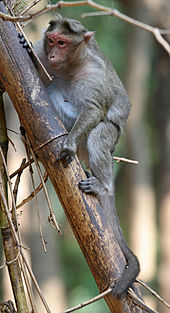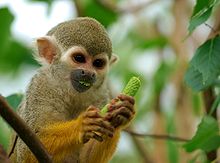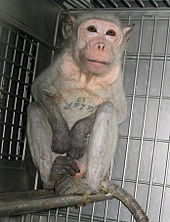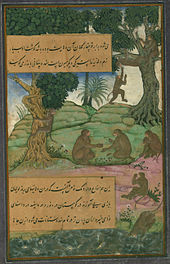
Monkey
About this schools Wikipedia selection
SOS Children volunteers helped choose articles and made other curriculum material See http://www.soschildren.org/sponsor-a-child to find out about child sponsorship.
A monkey is a primate of the Haplorrhini suborder and simian infraorder, either an Old World monkey or a New World monkey, but excluding apes and humans. There are about 260 known living species of monkey. Many are arboreal, although there are species that live primarily on the ground, such as baboons. Monkeys are generally considered to be intelligent. Unlike apes, monkeys usually have tails. Tailless monkeys may be called "apes", incorrectly according to modern usage; thus the tailless Barbary macaque is called the "Barbary ape".
The New World monkeys (superfamily Ceboidea) are classified within the parvorder of Platyrrhini, whereas the Old World monkeys (superfamily Cercopithecoidea) form part of the parvorder Catarrhini, which also includes the hominoids (apes, including humans). Thus, as Old World monkeys are more closely related to hominoids than they are to New World monkeys, the monkeys are not a unitary ( monophyletic) group.
Historical and modern terminology
According to the Oxford English Dictionary, the word "monkey" may originate in a German version of the Reynard the Fox fable, published circa 1580. In this version of the fable, a character named Moneke is the son of Martin the Ape. In English, no very clear distinction was originally made between "ape" and "monkey"; thus the 1910 Encyclopædia Britannica entry for "ape" notes that it is either a synonym for "monkey" or is used to mean a tailless humanlike primate. Such ambiguities persist. Colloquially, the terms "monkeys" and "apes" may still be used interchangeably. Due to its size (up to 1 m/3 ft) the mandrill is often thought to be an ape, but it is actually an Old World monkey. Also, a few monkey species have the word "ape" in their common name, such as the Barbary ape.
Later in the first half of the 20th century, the idea developed that there were trends in primate evolution and that the living members of the order could be arranged in a series, leading through "monkeys" and "apes" to humans. Monkeys thus constituted a " grade" on the path to humans and were distinguished from "apes".
Scientific classifications are now more often based on monophyletic groups, that is groups consisting of all the descendants of a common ancestor. The New World monkeys and the Old World monkeys are each monophyletic groups, but their combination is not, since it excludes hominoids (apes and humans). Thus the term "monkey" no longer refers to a recognized scientific taxon. The smallest accepted taxon which contains all the monkeys is the infraorder Simiiformes, or simians. However this also contains the hominoids (apes and humans), so that monkeys are, in terms of currently recognized taxa, non-hominoid simians.
A group of monkeys may be referred to as a mission or a tribe.
Physical description

Monkeys range in size from the Pygmy Marmoset, at 140 to 160 millimetres (5–6 in) long (plus tail) and 120 to 140 grams (4–5 oz) in weight, to the male Mandrill, almost 1 metre (3.3 ft) long and weighing 35 kilograms (77 lb). Some are arboreal (living in trees) while others live on the savanna; diets differ among the various species but may contain any of the following: fruit, leaves, seeds, nuts, flowers, eggs and small animals (including insects and spiders).
Some characteristics are shared among the groups; most New World monkeys have prehensile tails while Old World monkeys have non-prehensile tails or no visible tail at all. Some have trichromatic colour vision like that of humans, others are dichromats or monochromats. Although both the New and Old World monkeys, like the apes, have forward-facing eyes, the faces of Old World and New World monkeys look very different, though again, each group shares some features such as the types of noses, cheeks and rumps.
Classification
| Phylogeny of living (extant) primates | |||||||||||||||||||||||||||||
|
|||||||||||||||||||||||||||||
| Monkeys (in green brackets) are not a monophyletic group, since they exclude hominoids. |
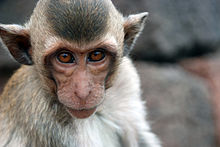
The following list shows where the various monkey families (bolded) are placed in the classification of living (extant) primates.
- ORDER PRIMATES
- Suborder Strepsirrhini: non-tarsier prosimians
- Suborder Haplorhini: tarsiers, monkeys, and apes
- Infraorder Tarsiiformes
- Family Tarsiidae: tarsiers
- Infraorder Simiiformes: simians
- Parvorder Platyrrhini: New World monkeys
- Family Callitrichidae: marmosets and tamarins (42 species)
- Family Cebidae: capuchins and squirrel monkeys (14 species)
- Family Aotidae: night monkeys (11 species)
- Family Pitheciidae: titis, sakis, and uakaris (41 species)
- Family Atelidae: howler, spider, and woolly monkeys (24 species)
- Parvorder Catarrhini
- Superfamily Cercopithecoidea
- Family Cercopithecidae: Old World monkeys (135 species)
- Superfamily Hominoidea: apes
- Family Hylobatidae: gibbons ("lesser apes") (15 species)
- Family Hominidae: great apes including humans (7 species)
- Superfamily Cercopithecoidea
- Parvorder Platyrrhini: New World monkeys
- Infraorder Tarsiiformes
Relationship with humans
The many species of monkey have varied relationships with humans. Some are kept as pets, others used as model organisms in laboratories or in space missions. They may be killed in monkey drives when they threatened agriculture, or used as service animals for the disabled.
In some areas, some species of monkey are considered agricultural pests, and can cause extensive damage to commercial and subsistence crops. This can have important implications for the conservation of endangered species, which may be subject to persecution. In some instances farmers' perceptions of the damage may exceed the actual damage. Monkeys that have become habituated to human presence in tourist locations may also be considered pests, attacking tourists.
In religion and culture, the monkey often represents quick-wittedness and mischief.
As service animals for the disabled
Some organizations, for example Helping Hands: Monkey Helpers for the Disabled, train capuchin monkeys as monkey helpers to assist quadriplegics and other people with severe spinal cord injuries or mobility impairments. After being socialized in a human home as infants, the monkeys undergo extensive training before being placed with a quadriplegic. Around the house, the monkeys help out by doing tasks including microwaving food, washing the quadriplegic's face and opening drink bottles.
In experiments
Macaques, especially the Rhesus Macaque, and African Green Monkeys are widely used in animal testing facilities, either wild-caught or purpose-bred. They are used primarily because of their relative ease of handling, their fast reproductive cycle (compared to apes) and their psychological and physical similarity to humans. In the United States, around 50,000 non-human primates, most of them monkeys, have been used in experiments every year since 1973; 10,000 monkeys were used in the European Union in 2004.
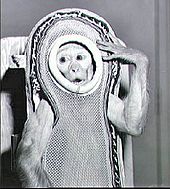
The use of monkeys in laboratories is controversial. Animal rights activists claim that their use is cruel and produces little information of value, and there have been many protests, vandalism to testing facilities and threats to workers. Others claim that it has led to many important medical breakthroughs such as the rabies vaccine, understanding of human reproduction and basic knowledge about brain function and that the prevention of harm to humans should be a higher priority than the possible harm done to monkeys. The topic has become a popular cause for animal rights and animal welfare groups.
In space
A number of countries have used monkeys as part of their space exploration programmes, including the United States and France. The first monkey in space was Albert II who flew in the US-launched V-2 rocket on June 14, 1949.
As food
Monkey brains are eaten as a delicacy in parts of South Asia, Africa and China. In traditional Islamic dietary laws, the eating of monkeys is forbidden. However, monkeys are sometimes eaten in parts of Africa, where they can be sold as " bushmeat".
Literature
Sun Wukong (the "Monkey King"), a character who figures prominently in Chinese mythology, is the main protagonist in the classic comic Chinese novel Journey to the West.
Monkeys are prevalent in numerous books, television programs, and movies. The television series Monkey and the literary characters Monsieur Eek and Curious George are all examples.
Informally, the term "monkey" is often used more broadly than in scientific use, and may be used to refer to apes, particularly chimpanzees, gibbons, and gorillas. Author Terry Pratchett alludes to this difference in usage in his Discworld novels, in which the Librarian of the Unseen University is an orangutan who gets very violent if referred to as a monkey.
The Winged monkeys are prominent characters in The Wizard of Oz.
Religion and worship
Hanuman, a prominent divine entity in Hinduism, is a Human-like monkey god. He bestows courage, strength and longevity to the person who thinks about him or the god Rama.
In Buddhism, the monkey is an early incarnation of Buddha but may also represent trickery and ugliness. The Chinese Buddhist " mind monkey" metaphor refers to the unsettled, restless state of human mind. Monkey is also one of the Three Senseless Creatures, symbolizing greed, with the tiger representing anger and the deer lovesickness.
The Mizaru or three wise monkeys are revered in Japanese folklore.
The Moche people of ancient Peru worshipped nature. They placed emphasis on animals and often depicted monkeys in their art.
The Tzeltal people of Mexico worshipped monkeys as incarnations of their dead ancestors.
Entertainment
- Sometimes in Tamil places, monkeys were trained in gymnastics by their catchers for public entertainment.
- Kiki the Hyperactive Monkey of Sentosa an anthropomorphic green crab-eating macaque performs in the defunct live nighttime spectacular, Magical Sentosa which is located at, Sentosa Island, Singapore.
Zodiac
The Monkey is the ninth in the twelve-year cycle of animals which appear in the Chinese zodiac related to the Chinese calendar. The next time that the monkey will appear as the zodiac sign will be in the year 2016.
